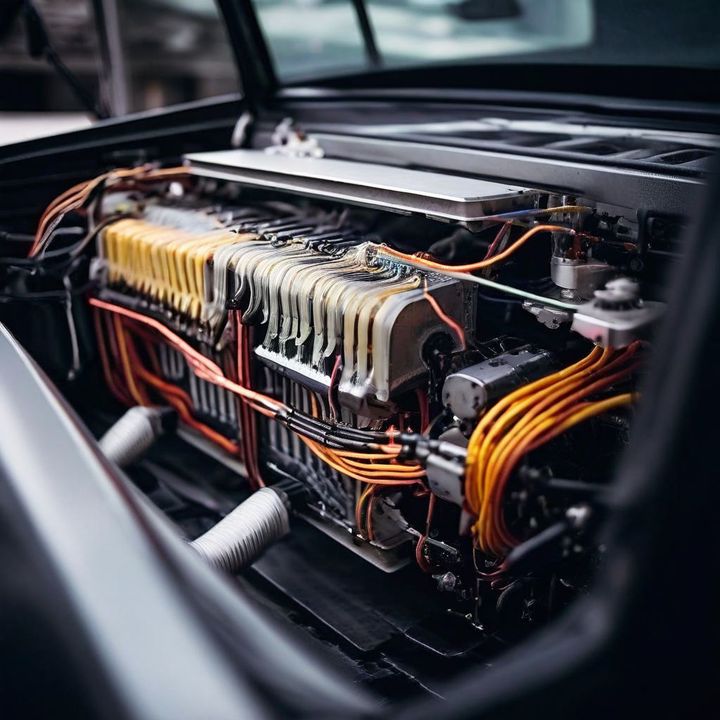
![Leaking Evaporator Core HVAC Car: Signs, Causes & How to Fix It [2024]](https://image.micdot.com/_xl/storage/1114/leaking-evaporator-core-hvac-car-2.png)

The evaporator core is a crucial component of a vehicle's heating, ventilation, and air conditioning (HVAC) system. It is responsible for absorbing heat from the air inside the cabin, allowing the system to provide cool, dehumidified air. A leaking evaporator core can significantly impact the performance of the HVAC system and lead to various issues. Understanding the signs, causes, and potential fixes for a leaking evaporator core is essential for maintaining a comfortable and efficient driving experience.
Before we dive into the causes and solutions, let's first understand the role of the evaporator core in your vehicle's HVAC (Heating, Ventilation, and Air Conditioning) system. The evaporator core is a crucial component that resembles a small radiator, typically located behind the dashboard or under the center console. It's responsible for absorbing heat from the air inside the cabin, allowing the refrigerant to evaporate and cool the air before it's circulated back into the vehicle.

Over time, various factors can contribute to the deterioration of the evaporator core, leading to leaks and potential system failure. Here are some of the most common culprits:
| Common Issues | Description |
|---|---|
| Corrosion | Formic acid forms when copper, water, and volatile organic compounds (VOCs) interact, wearing down the copper tubing inside the evaporator core over time. |
| Clogging | Dust, leaves, hair, and other debris can accumulate on the evaporator fins, restricting airflow and reducing cooling efficiency. |
| Degradation | The seams or welds in the evaporator core can degrade due to constant expansion and contraction as the system cycles on and off, leading to cracks or holes and refrigerant leakage. |
| Wear and Tear | Like any mechanical component, the evaporator core can succumb to wear and tear after years of use and exposure to temperature fluctuations. |
| Refrigerant Leaks | Over time, the seals, gaskets, and connections within the AC system can deteriorate, causing refrigerant to leak out, reducing the system's cooling capacity. |
One of the primary causes of evaporator core leaks is corrosion. The copper tubing inside the core can react with moisture and volatile organic compounds (VOCs) present in the air, forming formic acid. This acid gradually eats away at the metal, creating tiny holes or cracks that allow the refrigerant to escape.
Another common issue is clogging of the evaporator fins. These thin metal fins are designed to maximize heat transfer, but they can become clogged with dust, leaves, hair, and other debris over time. This buildup restricts airflow and reduces the evaporator core's cooling efficiency, potentially leading to leaks as the system struggles to maintain proper pressure.
Like any mechanical component, the evaporator core is subject to wear and tear over years of use and exposure to temperature fluctuations. The constant expansion and contraction as the system cycles on and off can cause the seams or welds to degrade, leading to cracks or holes and subsequent refrigerant leakage.
In addition to leaks originating from the evaporator core itself, refrigerant leaks can also occur due to deterioration of seals, gaskets, and connections within the AC system. As these components age, they can become brittle or develop cracks, allowing the refrigerant to escape and reducing the system's cooling capacity.
As a mechanic, diagnosing a leaking evaporator core requires a combination of visual inspection, specialized tools, and diagnostic procedures. Here's how I approach the process:
Visual Inspection
Perform a thorough visual inspection of the evaporator core and surrounding components
Look for signs of corrosion, discoloration, or physical damage
Check for unusual odors, moisture buildup, or oily residue around vents and components
Electronic Leak Detection
Use electronic leak detectors to pinpoint the exact location of a refrigerant leak
These tools can detect even the smallest traces of refrigerant around the dashboard and vents
Pressure and Vacuum Testing
Perform a pressure test or vacuum test on the AC system to check for leaks
Introduce a specific pressure or vacuum into the system and monitor for any changes
Borescope Inspection
Use a UV borescope (specialized camera on a flexible cable) to remotely access and inspect the evaporator core
Visually examine the core without extensive disassembly, saving time and reducing labor costs
Symptom Analysis
Pay close attention to symptoms reported by the vehicle owner or observed during operation
| Symptoms of Evaporator Core Failure |
|---|
| Warm air or reduced cooling performance |
| Strange odors from the vents, indicating mold or refrigerant leaks |
| Compressor not activating due to low system pressure |
| Inconsistent air temperature or fluctuating cooling |
| Presence of moisture or water leaks inside the cabin |
| Unusual noises like hissing, bubbling, or gurgling sounds |
Once I've diagnosed the issue, the next step is to repair or replace the leaking evaporator core. Here's what the repair process typically involves:

This is a complex job that requires complete disassembly of the dashboard to access the evaporator core
Replacement should be done by a professional technician due to the complexity and need for proper handling of refrigerants
Additional components like the expansion valve, receiver drier, and seals may need to be replaced as well
For clogged evaporator fins, professional cleaning or flushing may be recommended to remove debris and improve airflow
If corrosion is minor, using a sealant may temporarily fix small leaks, but replacement is the best long-term solution
While evaporator core leaks are sometimes unavoidable due to age and wear, there are several steps you can take to help prevent or delay their occurrence:
Regular Maintenance
Have the AC system inspected and serviced annually by a professional
Change cabin air filters regularly to prevent debris buildup
Controlling Indoor Air Quality
Minimize the use of products containing volatile organic compounds (VOCs) indoors to reduce corrosion
Use a whole-house dehumidifier to control indoor humidity levels
Air Purification and UV Light Treatment
Install an air purifier or UV light in the HVAC system to eliminate mold, bacteria, and other contaminants
The cost of replacing a faulty car AC evaporator core can vary significantly depending on the make and model of your vehicle, as well as labor costs in your area. On average, you can expect to pay anywhere from $600 to $1200 for parts and labor. The cost may increase further if additional repairs or replacements are needed, such as the expansion valve, receiver drier, or other components.
While the cost may seem substantial, it's important to remember that a properly functioning AC system not only ensures your comfort but also contributes to your safety by preventing driver fatigue and maintaining a clear windshield during hot and humid conditions.
A leaking evaporator core can be a frustrating and potentially costly issue, but with proper diagnosis, repair, and preventive maintenance, you can ensure the longevity and efficiency of your vehicle's HVAC system. As a mechanic, I understand the importance of a comfortable and reliable air conditioning system, and I'm committed to providing my clients with the best possible service and advice.
Remember, regular maintenance, controlling indoor air quality, and addressing issues promptly can go a long way in preventing evaporator core leaks and ensuring a pleasant driving experience. If you suspect any issues with your vehicle's AC system, don't hesitate to seek professional assistance. A skilled mechanic can diagnose the problem accurately and provide the necessary repairs to keep you cool and comfortable on the road.
The evaporator coil is responsible for absorbing heat from the air as it passes over, allowing the air conditioner to produce cold air. It contains the refrigerant that facilitates this heat transfer process.
Repairing a leaking evaporator coil is generally not possible or recommended. The only permanent solution is typically to replace the entire evaporator coil.
Corrosion in the evaporator coil is caused by the interaction of water, copper (from the coil's tubing), and volatile organic compounds (VOCs) in the air, which creates formic acid that erodes the copper over time.
You can reduce the risk of evaporator coil corrosion by minimizing the use of products containing VOCs in your home and installing UV lights or an energy recovery ventilator to improve indoor air quality.
Signs of a damaged evaporator coil include weak or warm airflow from the vents, the compressor not activating, and fluctuating temperatures or cooling performance.
Yes, a clogged drain line can cause condensation to back up and leak out, potentially leading to water dripping from the evaporator coil.
Pet urine can contribute to evaporator coil corrosion if animals urinate on or near the outdoor unit, as the urine can corrode the evaporator coils and other mechanical components.
If refrigerant leaks from the evaporator coil, the air conditioner will struggle to cool your home effectively, and the compressor may not activate due to low pressure in the system.
Yes, the vibrations that occur when the air conditioner is running can potentially weaken or puncture the evaporator coil's copper tubing, leading to refrigerant leaks.
It is important to address evaporator coil leaks promptly because refrigerant leaks can be potentially toxic, and a leaking coil can contribute to further damage to the air conditioning unit if left unrepaired.

Sarah isn't your average gearhead. With a double major in Mechanical Engineering and Automotive Technology, she dived straight into the world of car repair. After 15 years of turning wrenches at dealerships and independent shops, Sarah joined MICDOT to share her expertise and passion for making cars run like new. Her in-depth knowledge and knack for explaining complex issues in simple terms make her a valuable asset to our team.





